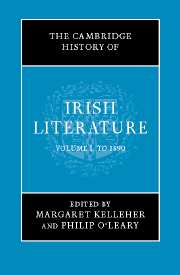Book contents
- Frontmatter
- Introduction
- 1 The literature of medieval Ireland to c. 800: St Patrick to the Vikings
- 2 The literature of medieval Ireland, 800–1200: from the Vikings to the Normans
- 3 The literature of later medieval Ireland, 1200–1600: from the Normans to the Tudors
- 4 Literature in English, 1550–1690: from the Elizabethan settlement to the Battle of the Boyne
- 5 Literature in Irish, c.1550–1690: from the Elizabethan settlement to the Battle of the Boyne
- 6 Prose in English, 1690–1800: from the Williamite wars to the Act of Union
- 7 Poetry in English, 1690–1800: from the Williamite wars to the Act of Union
- 8 Literature in Irish, 1690–1800: from the Williamite wars to the Act of Union
- 9 Theatre in Ireland, 1690–1800: from the Williamite wars to the Act of Union
- 10 Irish Romanticism, 1800–1830
- 11 Prose writing and drama in English, 1830–1890: from Catholic emancipation to the fall of Parnell
- 12 Poetry in English, 1830–1890: from Catholic emancipation to the fall of Parnell
- 13 Literature in Irish, 1800–1890: from the Act of Union to the Gaelic League
- 14 Historical writings, 1690–1890
- 15 Literature and the oral tradition
- Guide to major subject areas
- Index
- References
10 - Irish Romanticism, 1800–1830
Published online by Cambridge University Press: 28 March 2008
- Frontmatter
- Introduction
- 1 The literature of medieval Ireland to c. 800: St Patrick to the Vikings
- 2 The literature of medieval Ireland, 800–1200: from the Vikings to the Normans
- 3 The literature of later medieval Ireland, 1200–1600: from the Normans to the Tudors
- 4 Literature in English, 1550–1690: from the Elizabethan settlement to the Battle of the Boyne
- 5 Literature in Irish, c.1550–1690: from the Elizabethan settlement to the Battle of the Boyne
- 6 Prose in English, 1690–1800: from the Williamite wars to the Act of Union
- 7 Poetry in English, 1690–1800: from the Williamite wars to the Act of Union
- 8 Literature in Irish, 1690–1800: from the Williamite wars to the Act of Union
- 9 Theatre in Ireland, 1690–1800: from the Williamite wars to the Act of Union
- 10 Irish Romanticism, 1800–1830
- 11 Prose writing and drama in English, 1830–1890: from Catholic emancipation to the fall of Parnell
- 12 Poetry in English, 1830–1890: from Catholic emancipation to the fall of Parnell
- 13 Literature in Irish, 1800–1890: from the Act of Union to the Gaelic League
- 14 Historical writings, 1690–1890
- 15 Literature and the oral tradition
- Guide to major subject areas
- Index
- References
Summary
Ireland entered the period of Romanticism scorched by what Quaker writer Mary Leadbeater called the ‘ruthless fires’ of the 1798 rebellion. Reacting against the threat of Ireland separating from Britain and becoming a client state of France, William Pitt’s government moved quickly to draw the neighbouring island more securely to its side. Ireland was in future to send its electoral representatives (considerably reduced in number) to Westminster: the uneasy constitutional compromise that was the Dublin parliament was concluded. Other legal anomalies were cleared up also. The Copyright Act of 1709 was extended to Ireland, all but killing off an Irish publishing industry that was reliant on markets for cheap reprints in Ireland, Britain, the American colonies and the West Indies. More profoundly, the Union created a professional literary culture characterised by movement between and across the two islands. A chapter such as this one therefore has to account for an ‘Irish’ literature that developed both outside and inside Ireland: the vast majority of the writers discussed here either lived in Britain or published there, and London and Edinburgh play as important a part in the shaping of Irish Romanticism as Dublin, Belfast or Cork. Moreover, the experience of travel and cultural bi-location was itself to become an object of interest in the literature of the period.
Romanticism and Ireland
Romanticism across Europe took its political bearings from the Enlightenment, with its radical faith in social progress and human perfectibility. At the same time, however, the cultural forms and styles favoured by Romantic writers encode a rejection of central eighteenth-century tenets; thus, the liberated imagination takes precedence over enslaved reason, natural forces threaten to overwhelm the established social order, and idealism challenges realism.
- Type
- Chapter
- Information
- The Cambridge History of Irish Literature , pp. 407 - 448Publisher: Cambridge University PressPrint publication year: 2006
References
- 45
- Cited by



